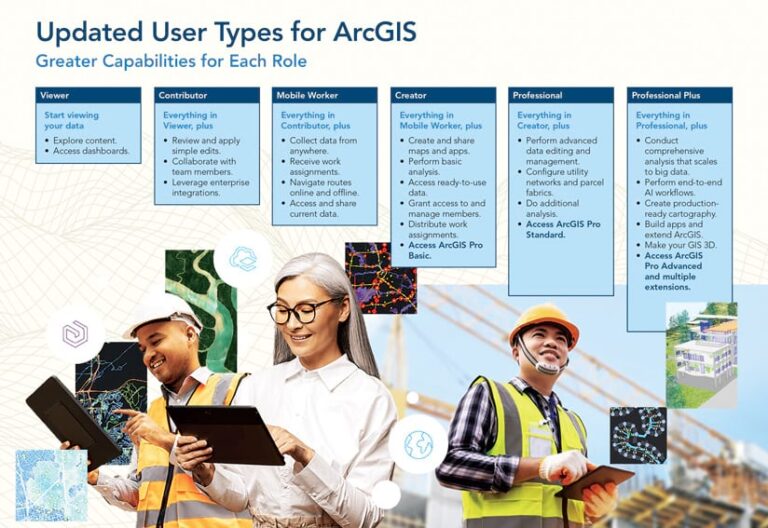New User Types Provide More ArcGIS Capabilities to Each Access Level
Organizations increasingly rely on GIS as a foundational IT system for mission-critical work. Esri continues to evolve ArcGIS as an enterprise-ready technology platform—available as an Esri-hosted software as a service, as well as a self-hosted geospatial infrastructure—that seamlessly integrates with other IT systems to bring the power of geospatial technology to the enterprise.
With the June 2024 update to ArcGIS Online, Esri updated ArcGIS user types—which provide the primary way to license and securely access the capabilities of ArcGIS—to offer expanded access to those capabilities across desktop, web, and mobile environments. This gives users the support and flexibility they need to work from anywhere, on any device. To simplify the administration process, Esri has included a set of most-used capabilities in each user type role.

Traditionally, users have accessed many ArcGIS capabilities through individual products, apps, and extensions—all with varying levels and forms of licensing, pricing, and entitlements. With Esri’s updated model, users and their teams get more ArcGIS capabilities than ever before at each access level. Rather than licensing multiple products, extensions, and apps, role-based user types provide tailored access to the ArcGIS capabilities that different users across an organization need. This approach delivers roles attuned to every user level, from those needing the lightweight Viewer and Contributor user type capabilities to those who need the most advanced capabilities of the complete ArcGIS system in Professional Plus. This simplified access quickly enables broader collaboration across stakeholders.
Read on to find out more about the benefits of the updated user types, what they are, how to use them to collaborate among roles in an organization, and how to smoothly transition to them.
Access ArcGIS Capabilities Anywhere
Esri’s updated user types deliver secure, flexible, and expanded access to ArcGIS. Here are the key benefits:
- Capabilities are aligned to team roles. User types provide each team member with role-based access to the ArcGIS capabilities, apps, and content they need to do their work. For example, team members who create content can map, analyze, and manage data to share with collaborators, who can then view it and make simple edits for accuracy.
- Team members have more flexibility to choose the environment they work in. Whether users are working in the office or in the field, they can seamlessly use and update ArcGIS content across desktop, web, and mobile devices.
- User type administration is now streamlined. Users can be confident that their organizations are equipped with the necessary tools for success. ArcGIS capabilities, apps, and content that were once purchased and provisioned separately are now included in user types.
- Organizations can scale as their needs grow. It is now easier to add user types to an ArcGIS organization. With the updated ArcGIS user types, organizations can progressively expand their capabilities when needed. Users simply move to the next level to obtain additional capabilities.
From having access to more capabilities at each role level to streamlining licensing management, the updated user types offer a range of benefits to organizations of all sizes.
Explore Esri’s Updated User Types
User types provide different levels of access to ArcGIS, ensuring that teams can employ the technology to collaborate efficiently and increase the reach of spatial capabilities across an organization. Some users need to map, analyze, and manage data. Other collaborators need to securely view, interact with, and perform basic reviews and editing of data.
Users who need to map, analyze, and manage data can choose from among the Creator, Professional, and Professional Plus user types. Each user type delivers access to a complete GIS, with more advanced capabilities available at each successive role level. These user types are a common place for users to get started, regardless of whether they’re working in ArcGIS Online, ArcGIS Enterprise, or ArcGIS Pro. They offer flexibility as an organization’s needs grow by allowing users to move up to the next level, add on apps and extensions, and incorporate additional user types.

- Creator serves as the entry point for accessing the essential capabilities of ArcGIS to produce dynamic maps and share content across an organization through a variety of prebuilt apps. Creator users can grant access and manage groups, members, and content, facilitating smooth collaboration. They can also enable an organization’s mobile workforce by assigning tasks and managing work assignments. The updated Creator user type replaces the previous Creator and GIS Professional Basic user types and includes everything in the Mobile Worker user type except location sharing. Creator now provides access to ArcGIS Pro Basic, making Creator the foundational role for accessing ArcGIS capabilities in desktop and web environments.

- Professional provides access to advanced editing, analytics, and data management capabilities across ArcGIS. With Professional, users can create and configure utility networks and parcel fabrics to manage mission-critical systems of record. The Professional user type replaces the GIS Professional Standard user type. It includes access to ArcGIS Pro Standard and everything in Creator.

- Professional Plus enables users to create production-ready cartography, make GIS 3D, and perform comprehensive analysis that scales to big data. Professional Plus users can leverage machine learning and deep learning models to perform end-to-end AI workflows. The Professional Plus user type replaces the GIS Professional Advanced user type. It now includes access to ArcGIS Pro Advanced, the most popular ArcGIS Pro extensions, and everything in the Professional user type.
Organizations can extend the reach of their GIS by giving additional team members roles that allow them to collaborate with internal content. Additionally, organizations can continue to provide public access to maps and open data. The Viewer, Contributor, and Mobile Worker user types support specific internal organizational needs.

- Viewer allows users to securely view their organization’s maps, apps, and dashboards so that they can make better decisions and monitor internal key performance indicators (KPIs) and status updates.

- Contributor leverages enterprise integrations to ensure that organizations operate with the most up-to-date information. It empowers users to review data, make simple edits to it, and collaborate on projects using a variety of data. The Contributor user type includes everything in the Viewer user type.

- Mobile Worker allows organizations to streamline office-to-field connectivity with secure field apps that help users efficiently receive work assignments, update data, navigate routes both online and offline, and share their location. The Mobile Worker user type includes everything in the Contributor user type.
Everything in the Viewer, Contributor, and Mobile Worker user types is included in the Creator, Professional, and Professional Plus user types except location sharing. The Location Sharing user type extension is included with Mobile Worker and can be added onto Creator and higher.
Boost Collaboration Across the Organization
Esri’s updated user types enable more users within an organization to securely leverage the power of ArcGIS. The user types are designed to foster collaboration by enabling users to work together in one unified environment. Here are some examples of how an organization can apply user types to successfully complete tasks and workflows.
A content creator utilizing the Creator user type can design and share interactive maps. With Creator, this user has access to new web editing tools as well as ArcGIS Pro Basic, so they can not only build maps but also share them with stakeholders via ready-to-use apps as part of the company’s decision-making processes. The content creator can share these maps and apps with any organizational stakeholders who have a Viewer user type, and those stakeholders can join a project and view and interact with any related maps.
A data editor leveraging the Contributor user type is responsible for reviewing and refining data on the web that was collected from the public. But this data editor relies on a cartographer to build interactive data visualizations. To produce these visualizations, the cartographer is assigned the Professional Plus user type, giving them access to ArcGIS Pro Advanced and its extensions. With Contributor, the data editor can view and update the public data entries while the cartographer, with their Professional Plus user type, can create high-end cartography. The organization can then share that map with the public.
A GIS specialist is assigned the Professional user type, which allows them to create complex data models using ArcGIS Pro Standard. The GIS specialist can then publish the data to ArcGIS Online or ArcGIS Enterprise and create a web map for field technicians to use in focused field apps. Each technician is assigned a Mobile Worker user type, so they can sign in to the field app, find the web map, and add data collected in the field as needed.
These real-world examples demonstrate the versatility and effectiveness of the updated user types in ArcGIS. By assigning people to the appropriate user types, organizations can optimize their licensing investments, empower users with the right capabilities, and foster a collaborative work environment that drives success.
Using the Updated User Types
Updated user types for ArcGIS Online and ArcGIS Enterprise are now available. But what does this mean for current subscriptions, and how can users get started?
For ArcGIS Online Users
ArcGIS Online users can take advantage of the updated user types now. The updated user types became available with the June 2024 update of ArcGIS Online, delivering expanded capabilities and apps to each role.
For ArcGIS Enterprise Users
Updated user type licenses for ArcGIS Enterprise became available to purchase with the June 2024 update of ArcGIS Online and will be available for use in ArcGIS Enterprise in November 2024 upon upgrading to version 11.4.
For ArcGIS Pro Users
Since ArcGIS Pro can be administered through ArcGIS Online and ArcGIS Enterprise, the updates will be reflected in their respective releases.
Learn More
Explore the updated user types or contact your Esri representative to learn more.

